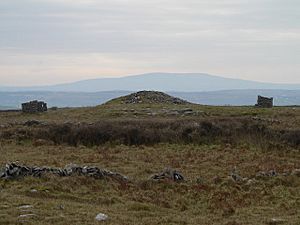Poulawack Cairn facts for kids

Poulawack Cairn in 2006
|
|
| Location | Carran, The Burren |
|---|---|
| Region | Ireland |
| Coordinates | 53°01′55″N 9°08′41″W / 53.032°N 9.14472°W |
| Type | Cairn |
| History | |
| Periods | Neolithic, Bronze Age |
| Site notes | |
| Excavation dates | 1934 |
| Ownership | on private property |
| Public access | Yes |
Poulawack Cairn is an ancient stone mound where people were buried long ago. It is located in a special area called the Burren in County Clare, Ireland. This cairn is a very important historical site.
Contents
Where is Poulawack Cairn?
Poulawack Cairn is found in a place called Poulawack, near the village of Carran. It sits on private land, but visitors can usually go and see it.
Close by, you can also see an old stone fort. These forts are known as a cashel or a ringfort. Other big stone mounds like Poulawack are on Turlough Hill and Slievecarran in the Burren.
What is Poulawack Cairn Like?
Today, this ancient mound is about 21 meters (69 feet) wide. It stands about 2.5 meters (8 feet) high in the middle.
How Was It Discovered?
A person named Hugh Hencken from Harvard University first dug up parts of the cairn in 1934. Since then, many other experts have studied it. At first, Hencken thought the cairn was built in two quick steps during the early Bronze Age. This was around 2000 to 1500 BC.
Building Over Time
However, experts now agree that Poulawack Cairn was built over a very long time. It took about 1,800 years to complete, in three main stages.
First Stage: Neolithic Period
The first part, called Phase I, was built around 3500 BC. This was during the Neolithic period, also known as the New Stone Age. It was a stone box, called a cist, made from flat limestone rocks. This cist held the remains of three adults and one child. It also had some objects with them. This first burial area was likely covered by a low pile of stones. A circle of stones, about 10 meters (33 feet) wide, surrounded it.
Second Stage: Bronze Age Burials
Phase II happened more than 1,000 years later, around 2000 BC. This was during the early Bronze Age. At this time, three more burial cists were added to the cairn. The original stone pile had probably started to spread out. Eight more people were buried in these new cists. These burials might have happened over a period of time.
Third Stage: Final Expansion
The third and final stage of building happened between 1600 and 1400 BC. This was a quicker building period. The original cairn was made much bigger. A new circle of stones, about 14 meters (46 feet) wide, was built around it. Three more cists were added, holding three more burials. The remains of a fourth person were found directly on the ground. They were covered with stone slabs and then included in the growing cairn.
Who Was Buried Here?
In total, only 16 people were buried at Poulawack Cairn over 1,800 years. This shows that, like at the famous Poulnabrone dolmen nearby, only very special people were likely buried at this important site.


